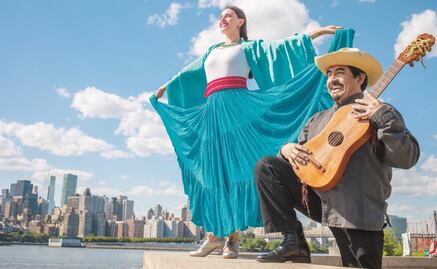This week in the city of New York , several meetings, conversations, tastings, and exhibitions of art rooted in the tradition of the state of Oaxaca, Mexico , have impressed audiences from all around the world.
Seven successful women from Oaxaca have brought an art cycle entitled: " Mujeres Oaxaqueñas: tierra y luz ” (Oaxacan Women: Earth and Light), featuring a chef, a mezcalera teacher, a designer with a social focus, a ceramist, a traditional weaver, a dancer, and a performance artist. The cycle, which will take place from July 26 through 29 , covers various locations in Manhattan .
Organized by the Cultural Institute of Mexico in New York and the civil group Poco a Poco , the meetings also serve to reflect upon the land of Oaxaca and the women’s sense of belonging, as well as the impact of their innovative work in their communities.
One of the participants is Pastora Gutiérrez Reyes, a Zapotec woman, founder of Vida Nueva , the first cooperative operated by women in the community of Teotitlán del Valle which, since 1997 , has offered opportunities for financial independence and educational services in the community.
The productive projects promoted by Vida Nueva highlight the creation of textiles, which are sold directly in the community. Pastora Gutiérrez’s work, in addition to financial resources from the 14 women who work in the cooperative, has won public recognition in Teotitlán del Valle.
In an interview with Notimex , Gutiérrez said that their perseverance has allowed them to preserve the Zapotec textile tradition and, at the same time, explore the creativity of each of the New Life weavers, made up of widows, single mothers, and heads of families.
"Now we are more independent in terms of deciding the colors and measurements we want to use, as well as the drawings we want to put on the rugs. We have the freedom to do something more creative and, little by little, we have also learned to put a fair price on our work," she said.
Furthermore, Vida Nueva carries out a special project in its community every year, such as reforesting a wasteland or installing trash cans, and in other "more rural and more needy" settlements than Teotitlán del Valle.
"I am happy and grateful that I have been invited to come to New York so that people can learn a little about our life, our work and our culture, and so that we can show our textiles and products to more people," Gutiérrez said.
Gutiérrez participated in the inaugural session of the cycle, in a conversation accompanied by tastings and cocktails prepared by Yana Volfson, mixologist at the Cosme and Atla restaurants . There was also a dialogue with the textile designer Ana Paula Fuentes .
For her part, Aurora Toledo, chef and founder of the renowned restaurant Zandunga Sabor Istmeño , in the center of the city of Oaxaca, also participated in the inaugural session of the cycle, as well as in a panel with the mezcalera teacher Graciela Ángeles Carreño , from the Real Mining company .
In Zandunga , founded 15 years ago , the two sons of Oaxacan painter Francisco Toledo , have worked hard to promote the traditional cuisine of the Isthmus of Tehuantepec , composed of garnachas, baked cochito, wedding stew, banana molasses and corn tamales, among other dishes.
"We want to show our culture through our cuisine and position Istonian and Oaxacan cuisine in parallel with any other in the world. We seek to share our flavors with the world because we have a culinary tradition worthy of promotion, "explained Toledo.
The other Oaxacan creators that participate in the cycle are the mezquita Graciela Ángeles Carreño, from the Mezcal Real Minero ; Ana Paula Fuentes, founding director of the Textile Museum of Oaxaca ; Alicia Jiménez, artist and ceramist ; and Evelyn Méndez, dancer and performance artist .
dm
Noticias según tus intereses
[Publicidad]
[Publicidad]
















